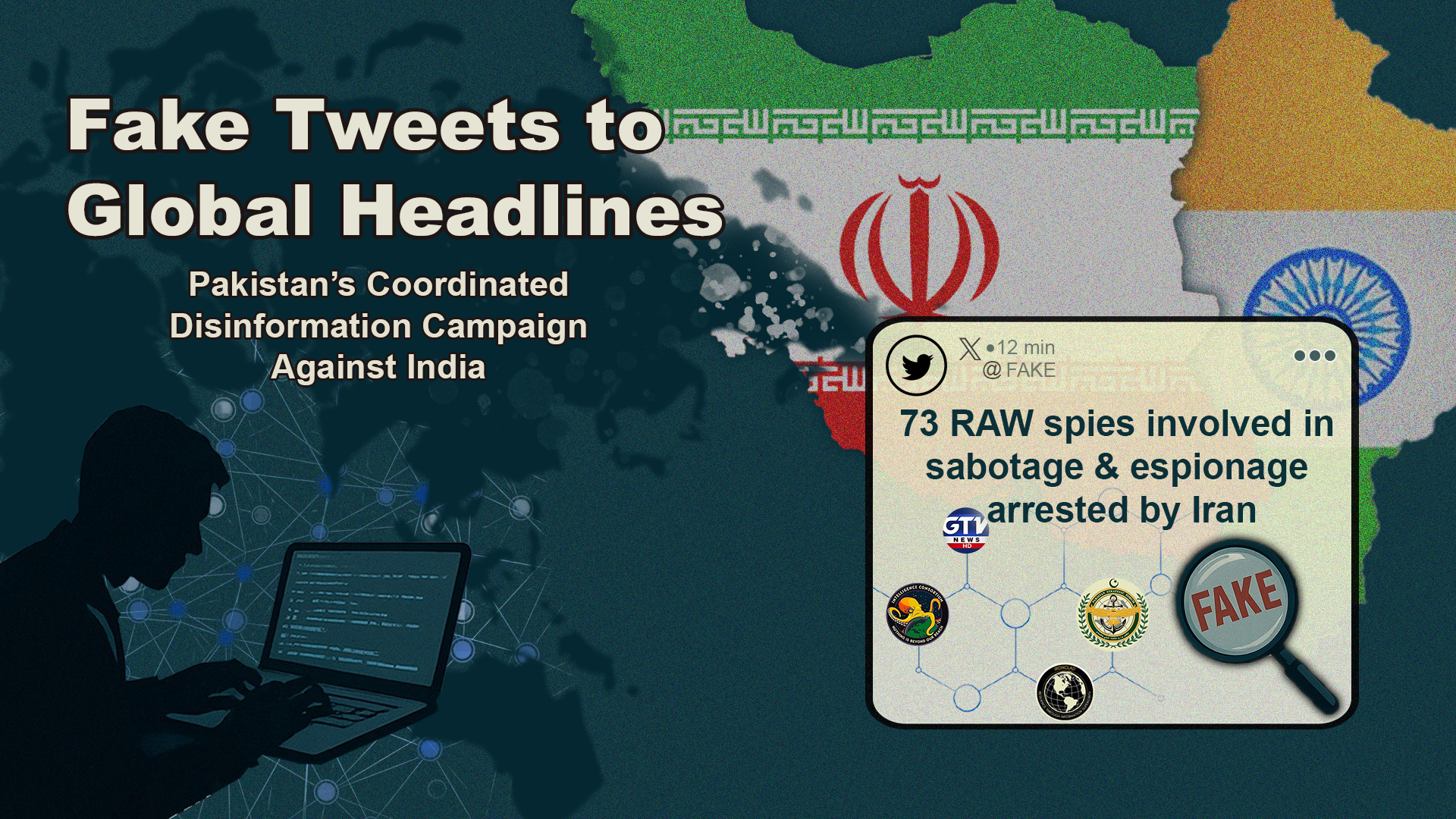Part 1: Background and Context
Understanding this disinformation campaign requires looking at the bigger picture of regional politics in South Asia and the Middle East. When the Israel-Iran conflict escalated in June 2025, it created a perfect storm for Pakistan to launch a sophisticated information warfare operation against India.
Pakistan found itself in a difficult position during this period. The country had been strengthening its ties with Western nations, which naturally created tension with Iran, a key regional partner. Pakistan’s leadership became concerned that their growing closeness with the West might damage their relationship with Iran, especially as the Israel-Iran conflict intensified.
Rather than addressing these concerns through traditional diplomatic channels, Pakistan chose a different path. They activated what appears to be a well-prepared information warfare infrastructure that had been built over years using public resources and economic funds. The strategy was simple : create a false narrative that would make India appear as the real threat to Iran, thereby deflecting attention from Pakistan’s own diplomatic challenges.
The timing of this operation reveals its calculated nature. The Israel-Iran conflict began around June 13, 2025, and within just 24 hours, Pakistani propaganda accounts were already spreading coordinated messages across social media platforms. This rapid response suggests that the disinformation network was not created spontaneously but was a pre-existing system ready to be activated when the right opportunity arose.
The core false narrative centered on claims that India had betrayed Iran by helping Israel with intelligence operations. Rather than engaging in diplomatic solutions, Pakistani actors launched a comprehensive information warfare campaign targeting India.
Part 2: Media Narrative Spread
The media campaign to spread these false narratives was more diverse . Pakistani media outlets served as the primary launching pad for the disinformation, with major publications like The Nation and DND News leading the charge with unverified reports about Indian spy arrests.
The Nation published claims that Pakistan had arrested an Indian spy near the Iran-Pakistan border, citing former Foreign Secretary Aizaz Ahmad Chaudhry. This report was significant because it gave an official veneer to what would later become a completely fabricated story. The article claimed this was the most significant espionage-related arrest since Kulbhushan Jadhav’s capture in 2016, deliberately invoking a previous controversial case to add credibility.

DND News took this narrative even further, publishing detailed analysis about alleged arrests of Indian spies by Iran. The outlet claimed that Iran’s Revolutionary Guard Corps had arrested 73 people, including 13 Indians, for spying for Israel. However, when examined closely, these reports provided no credible evidence and relied heavily on previously debunked Pakistani social media accounts like South Asia Index, Iron clad, Defense Intelligence.


The sophisticated nature of this media campaign becomes clear when we examine how it spread beyond Pakistan’s borders. Publications in Egypt, Russia, and China began republishing these stories, often without independent verification.
Al Diplomacy, based in Egypt, published articles that quoted dubious Twitter accounts as their primary sources. This article brought in the Kashmir conflict to make the narrative more emotionally charged and politically complex.

One Arabic publishing news media outlet Al-Estiklal quoted an account claiming to be “Tejasswi Prakash, a prominent human rights advocate and former member of India’s once-ruling Congress Party,” who alleged that 73 Indian nationals had been arrested in Iran on espionage charges for spying on behalf of Israel. However, investigation revealed this account to be a frequent fake news peddler with no connection to the Indian Congress party.

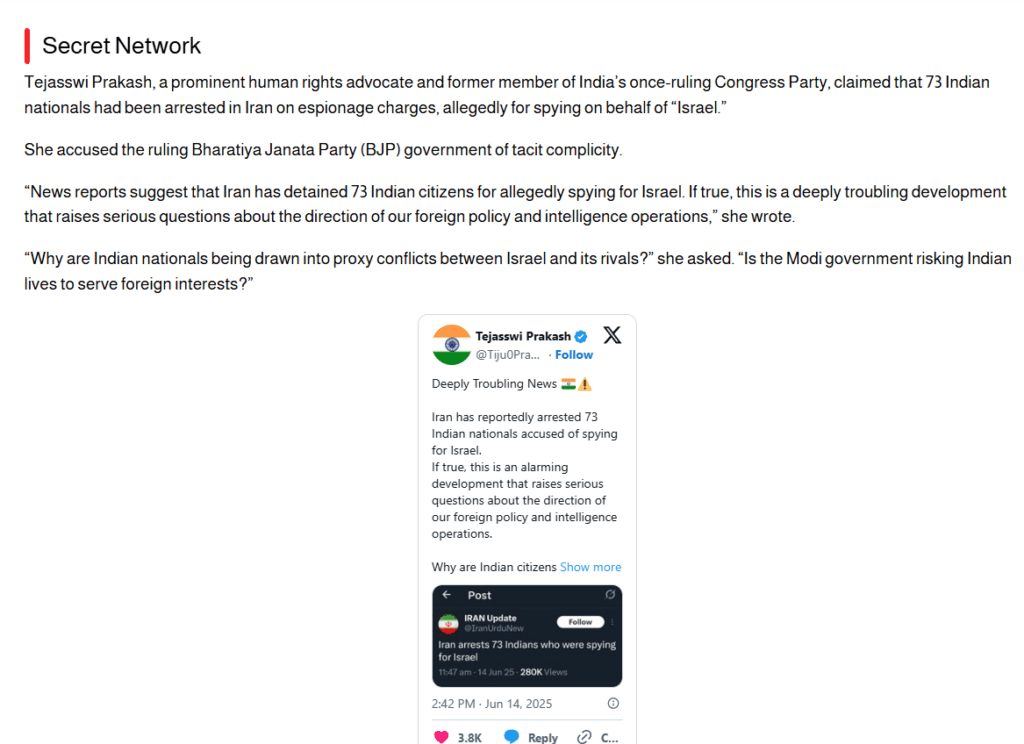
The account was earlier running under the username @tiju786 and later changed to Tiju0Prakash, and analysis of its posting history shows a pattern of spreading misinformation aligned with Pakistani narratives. The account frequently posted content condemning the Indian government and spreading false claims about Indian military losses. Its follower base included numerous Pakistani users, and the account was found to amplify anti-India sentiments consistently.

Another particularly concerning example came from The Intel Drop, which described itself as an “Iceland-based volunteer group.” This outlet published a completely unfounded conspiracy theory without any evidence, claiming: “The Iranian government and its people must now grapple with the painful truth: the betrayal came not from Western agents or Zionist operatives, but from a supposed ‘ally’ that has long positioned itself as a strategic partner, India. While the West and Israel have long been viewed as adversaries by Iran, India has presented itself as a reliable partner, particularly through its involvement in the development of the Chabahar Port and other economic ventures. But behind these activities lies a far darker truth: RAW agents have actively worked to compromise Iranian sovereignty. The Iranian people must now see through the veil of this false friendship and recognize the role of India in undermining their security.”

The sentiment analysis of these articles revealed a consistently negative portrayal of India across all publications.
Deeper Analytical Observations:
1.Framing Technique: India is consistently portrayed not just as a foreign intelligence facilitator but as a neo-colonial digital actor.
2.Ideological Narrative: Articles frame India-Israel relations through a civilizational/ideological lens—especially in South Asia Journal.
3.Media Bias: Articles show heavy pro-Iran or pro-Pakistani alignment; claims are made without balanced counterpoints or evidence.
4.Disinformation Signatures:
•Recurring use of terms like “digital colonization”, “fifth column”, “Hindutva-Zionist alliance”.
•Repetition of unverifiable data (e.g., “700 spies”, “73 Indians arrested”) in multiple sources.
Russian outlet Pravda, known for spreading disinformation, also joined the campaign, further internationalizing the false narrative. Chinese outlet Inf.news added an Asian perspective to the story, helping to spread the disinformation across different regional audiences.
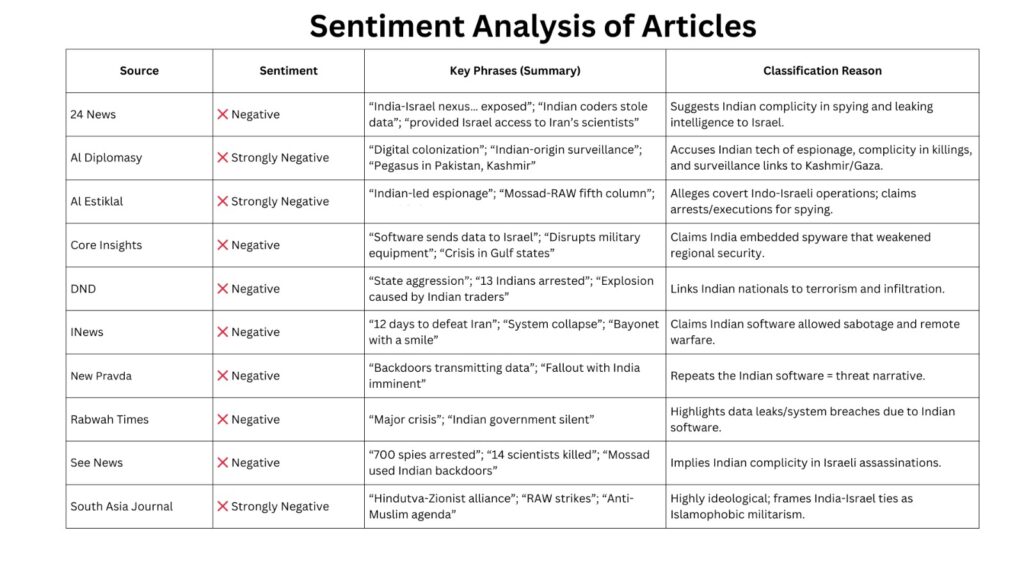
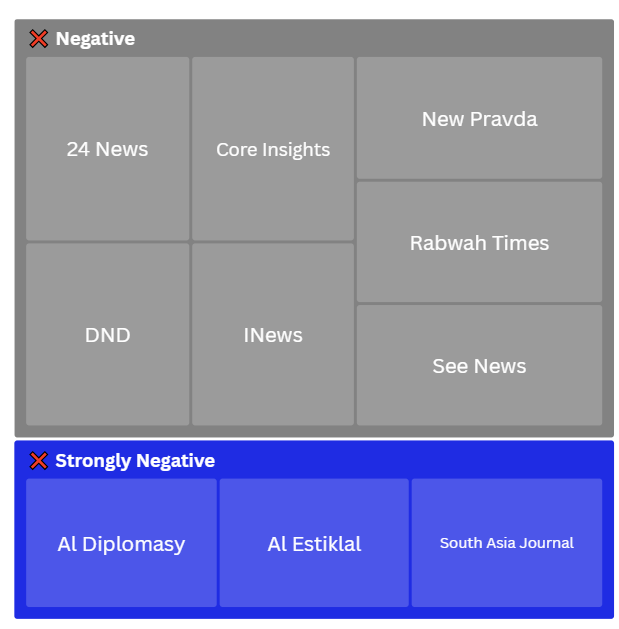
Part 3: Twitter Accounts Narrative Spread
Twitter served as the primary battlefield for spreading the false narrative, with a carefully coordinated network of accounts working in unison to amplify the message.
Our investigation identified 117 Twitter accounts that actively spread the propaganda about Indian spies being arrested by Iran. The precision of this operation becomes clear when we examine the timing: the very first account to share this narrative was @GTVNewsPk, which posted at exactly 00:41 on June 14, 2025. This was less than 24 hours after the Israel-Iran conflict escalated, demonstrating the rapid response capability of this disinformation network.
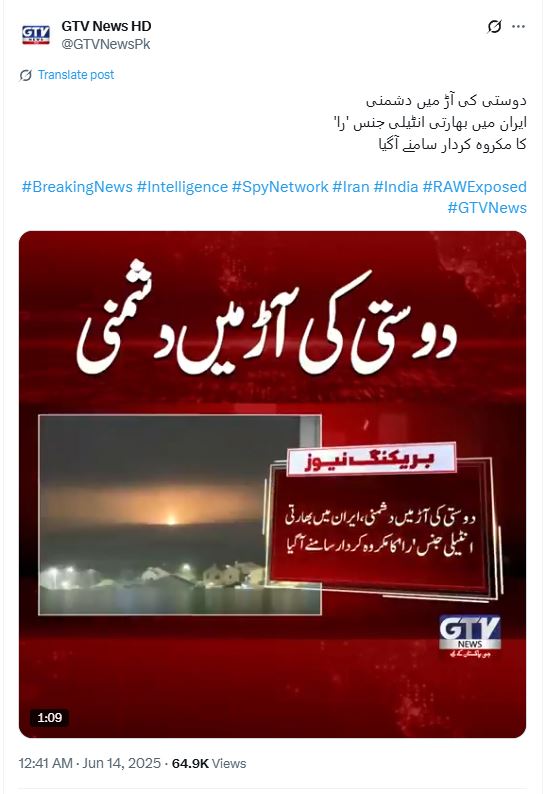

The pattern of activity following this initial post reveals the coordinated nature of the operation. Rather than organic spread, the narrative exploded across multiple accounts within hours. All 117 identified accounts began sharing similar content, using identical hashtags and often the same graphics, indicating they were working from a coordinated playbook.
The analysis of posting patterns shows that June 14 was the peak day for this disinformation campaign on Twitter. The timestamp analysis reveals clusters of activity at specific times, suggesting that the operators were working in shifts or following a predetermined schedule. These accounts had been previously identified as fake news peddlers through our ongoing monitoring efforts. Many showed signs of artificial behavior, including posting at unusual hours, sharing content outside their normal topics of interest, and showing engagement patterns that suggested automated boosting rather than organic interaction.

All the tweets in the above graphic were posted on 14 June 2025
The narrative spread simultaneously across Facebook as well, where we identified 111 accounts, all operating from Pakistan. These Facebook accounts used community groups and news pages to spread the disinformation, taking advantage of these platforms’ recommendation algorithms to reach wider audiences. The coordinated timing between Twitter and Facebook posting suggests a unified command structure managing the entire operation.

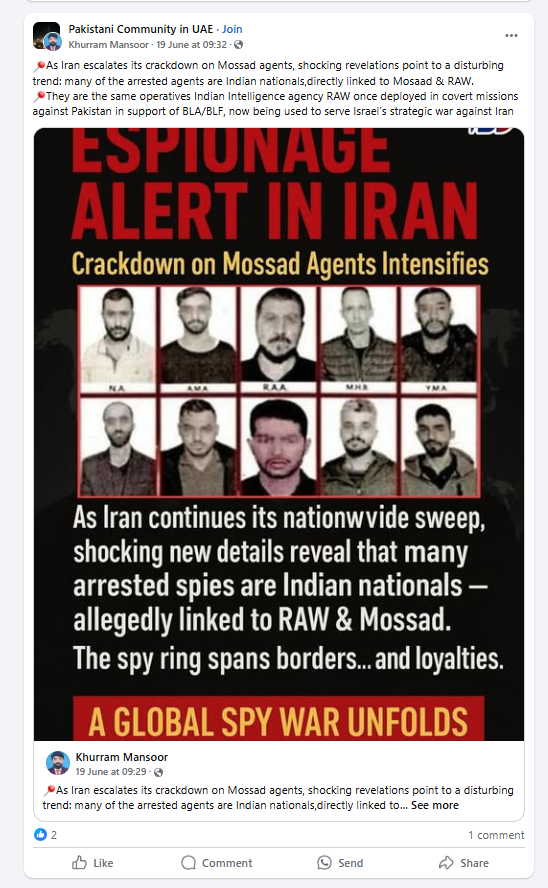
Narrative Growth of ‘Indian Spies Arrested by Iran’ on Twitter and Facebook (14–30 June)
The graph illustrates the daily volume of posts on Twitter (pink) and Facebook (blue) related to the narrative that “Indian spies were arrested by Iran” between 14 and 30 June.
Peak Activity: Both platforms saw a major spike on 14 June, with over 35 posts on each, marking the origin of the narrative’s viral spread.
Gradual Decline: After the initial surge, post frequency dropped sharply on 15 June, with minor fluctuations in the following days.
Mid-June Resurgence: A secondary rise occurred between 16 and 18 June, especially on Facebook.
End-of-Month Uptick: A slight increase in tweets is visible on 30 June, suggesting a minor revival of interest.

Twitter and Facebook mirrored each other in trend, though Twitter maintained slightly more consistent engagement in the latter half of the month.
Part 4: Using International Influencers for Their Propaganda
Another aspect of this disinformation campaign was its use of international influencers to legitimize and amplify Pakistani narratives to global audiences.
Jackson Hinkle emerged as a key figure in this influence operation. He has consistently promoted Pakistani narratives and anti-India messaging across multiple conflicts. His involvement in this campaign follows a pattern established during the Pahalgam attack, where he actively promoted Pakistani false flag theories.
During the Pahalgam incident, Pakistani officials began spreading false narratives within hours of the attack, with former Pakistani High Commissioner Abdul Basit playing a central role. Basit appeared on Hinkle’s livestream to promote the claim that the attack was an Indian false flag operation, telling a global audience that “Kashmiri mujahideen never target civilians.” This collaboration demonstrates how Pakistani diplomatic figures have cultivated relationships with Western influencers to spread their messaging.
The concerning aspect of Hinkle’s influence is revealed through analysis of his engagement patterns. An NCRI Research shows that over 40% of his social media engagement exhibits bot-like or automated behavior, suggesting that his apparent reach and influence may be artificially inflated. This makes him an ideal vehicle for spreading disinformation, as his content appears to have organic support when it may actually be artificially boosted.
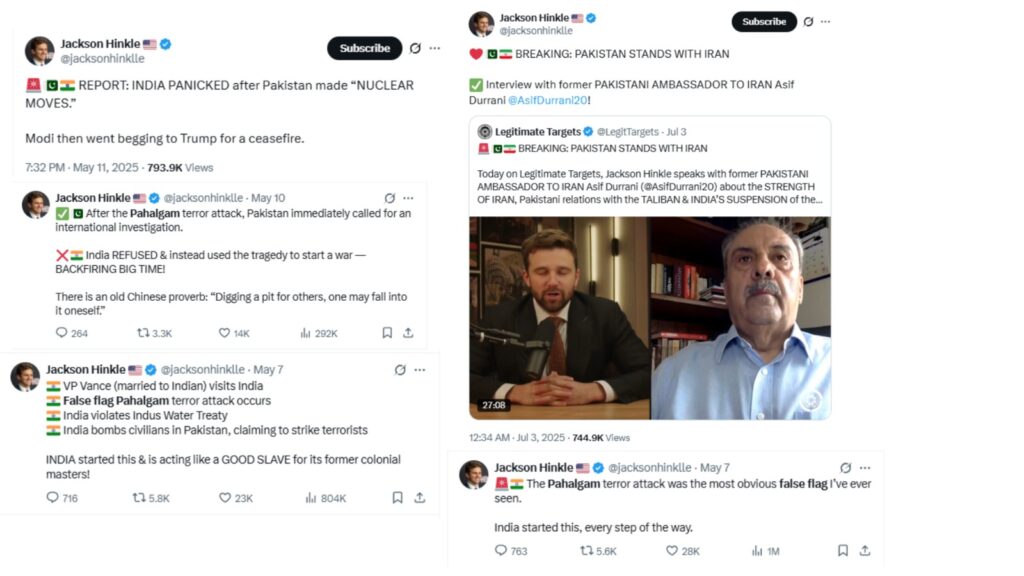
Suleiman Ahmed represents another key international influencer in this operation. With 729,100 followers, Ahmed amplified the false narrative about Indian spy arrests on June 17, 2025. His post claimed that “Iranian media has reported 20 Indian nationals linked to Zionist Mossad have been taken into custody for espionage. They were allegedly involved in cross border terrorism activities in both Pakistan and Iran.” This message reached hundreds of thousands of users globally, spreading the Pakistani disinformation far beyond its original geographic scope.

The strategic use of these international influencers serves multiple purposes. First, it gives Pakistani narratives credibility by having them endorsed by non-Pakistani voices. Second, it helps these messages reach audiences who might be skeptical of direct Pakistani government messaging. Third, it creates the appearance of international consensus around Pakistani viewpoints, making them seem more legitimate to casual observers.
Part 5: A New Line of Propaganda Claims That India Is Using Baloch People to Attack Both Pakistan and Iran
The most insidious aspect of this disinformation campaign was the introduction of a completely fabricated narrative about Indian manipulation of Baloch separatists. The Balochistan narrative emerged as Pakistani operators realized they could kill two birds with one stone. By claiming that India was using Baloch people to attack both Pakistan and Iran, they could simultaneously deflect attention from their own handling of the Balochistan issue while creating additional tension between India and Iran.
The campaign manufactured elaborate fictional identities and backstories for alleged Indian-Baloch operatives. Claims emerged that missing persons like Ismail Baloch were actually RAW-Mossad operatives with codenames like “Golden Eagle.”
The hashtag #RAW_Mossad_Nexus became the primary vehicle for spreading these Balochistan-related narratives. Between June 14 and 30, this hashtag was used to share multiple false claims, including that Mehrang Baloch was exposed as Mossad’s “Golden Eagle” and that the RAW-Mossad nexus represented a threat to regional stability.
The timing of these Balochistan narratives was carefully coordinated with the broader Iran-India disinformation campaign. New accounts were created specifically in April 2025 to spread these narratives, suggesting months of preparation.
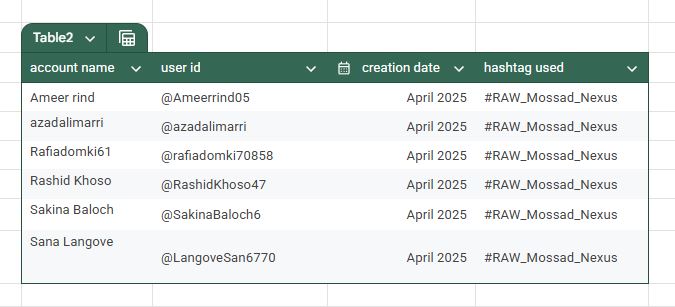
We closely analysed one account Rashid Khoso between the time interval of 17-18 June.

The graphs show:
- Timeline Chart: Shows the rapid, consistent posting pattern over time
- Hourly Distribution: Reveals suspicious clustering of tweets during specific hours
- Interval Distribution: Shows an unnaturally high number of tweets posted within minutes of each other



Bot-like Evidence:
- Extremely short intervals between posts (some under 1 minute)
2. Consistent posting frequency that’s too regular for human behavior
3. High-volume posting in concentrated time periods
4. Lack of natural posting patterns that humans typically display
The timing of these Balochistan narratives was carefully coordinated with the broader Iran-India disinformation campaign. New accounts were created specifically in April 2025 to spread these narratives, suggesting months of preparation. These accounts shared identical graphics and messaging, using the same hashtags and often posting at coordinated times.
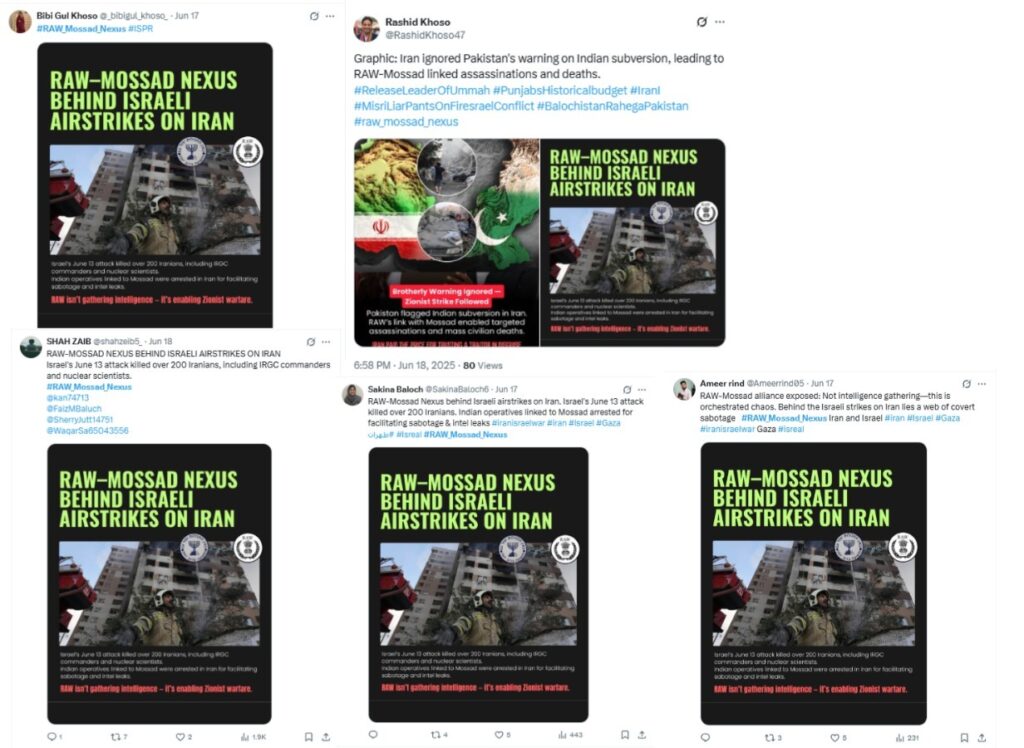
The sophistication of this Balochistan disinformation reveals several concerning trends. First, it shows how state-sponsored information operations are becoming more complex, weaving together multiple narratives to create comprehensive alternative realities. Second, it demonstrates how real ethnic conflicts and human rights issues can be weaponized for geopolitical gain. Third, it illustrates how disinformation campaigns increasingly target multiple audiences simultaneously, crafting different aspects of the same false narrative to appeal to different regional and international audiences.
The Bottom Line
This wasn’t just some random rumors spreading on Twitter. Pakistan ran a massive fake news operation that used everything they could get their hands on – fake news stories, social media bots, international influencers, and even made-up stories about ethnic groups. They created completely false stories to make it look like India was spying on Iran.
Here’s what they did: They made up fake news reports, used armies of fake social media accounts, twisted stories about Baloch separatists, and got popular online personalities like Jackson Hinkle and Suleiman Ahmed to spread their lies. All of this was carefully planned and coordinated.
Why did they do it? Pakistan wanted to take the heat off their own problems and make India look bad to other countries in the region. It was like pointing fingers at someone else when you’re the one who broke the vase.
The scary part? In today’s world, lies can travel faster than the truth , and sometimes that’s all it takes to fool millions of people.


